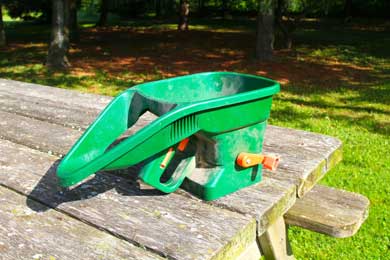In the last blog on my lawn care adventure, I explained how nitrogen (N), phosphorus (P) and potassium (K) are the three main elements that all plants need for growth – including the grass of your lawn. The three numbers you’ll find on any legitimate fertilizer bag or box indicates the percentage composition for each of these elements in the order N-P-K. I also explained how a soil test is really the only way to get an accurate sense of how much N, P and K your soil needs. Proper application is better for your pocket book and the environment.
Getting the Right Source
As my soil test showed, my never-fertilized-in-25-years lawn was low in potassium (no surprise there), so I went to the hardware store looking for fertilizer with a hefty last number. But I wanted a solid first number too, even though soil tests never even attempt to determine nitrogen levels. The reason is kind of interesting.
Nitrogen, in the form that plants can absorb, is often more mobile in the soil than other nutrients. And if this wasn’t enough, the amount of nitrogen that’s available to plants is also a function of soil temperature. The colder it gets, the less nitrogen is available for plants to take up. Both these things make pinpointing nitrogen levels in the lab more or less pointless. That’s why nitrogen recommendations are always based on the plants being grown, not lab tests. Yes, it’s a guess, but an educated one. And in the case of your lawn, nitrogen requirements are pretty high if you want that nice, lush green colour to develop.
When I went to the hardware store to buy fertilizer for my lawn, I got an annoying surprise. Some government bureaucrats somewhere don’t think I’m responsible enough to be trusted with phosphorus. They don’t think you are, either. That’s why lawn fertilizers everywhere almost always have zero as the middle number these days. The idea is that phosphorus run off from lawns is one cause of algae growth in water courses, though admittedly a very small one. At the moment my lawn doesn’t need phosphorus, so I’m okay. If yours does, you’ll find fertilizer blends with numbers other than zero in the middle at farm supply outlets. One good thing about government overstepping its legitimate bounds is that it’s usually still possible to do the reasonable thing legally as long as you know how.
Getting the Right Rate
A specific amount of fertilizer spread over a specific area. This is what getting the rate of application right is all about. In my case, the soil test report recommended four applications of 12-0-18 over the course of the season, and I’m just about to apply my second dose. This translates to one quarter of a 14kg bag per 1000 square feet of lawn. And to make this happen I’m using a hand-crank fertilizer/seed spreader. It’s cheap (about $30), but more importantly for me it’s small. About the size of a loaf of bread, it easily hangs in my highly crowded, though decently organized garden shed. I found it interesting that the fertilizer recommended for the entire season is labeled for fall use. My soil needs lots of potassium (denoted by the 18% last number) to correct a deficiency, and fall fertilizers are rich in potassium.

Spreading at the Right Time
Early spring, late spring, mid-summer, and early fall. These are the four optimal times for fertilizing your lawn, and it surprised me when I learned about it. Sure, everybody knows about spring fertilizing, but I hadn’t realized the value of adding nutrients in the fall. As it turns out, grass wants to put on a lot of growth after Labour Day. What’s deceiving is that most of that growth happens below ground. Plenty of rain and cool days are typical during autumn, and that’s what makes grass roots grow best. And while good roots this year means great grass next summer, it all depends on having plenty of nutrients in the soil – especially potassium.
Does it need to rain right away to make fertilizer work? Can I fertilize the lawn at the cottage without ruining the water? What should I do if my soil test shows problems with micronutrients, soil pH or too much of a certain nutrient? Come back next time and I’ll answer these questions and report on the results of my lawn fertilizing experiment for this season.
To read the first installment of my lawn learning journey, read “Lawn Fertility Adventure”.